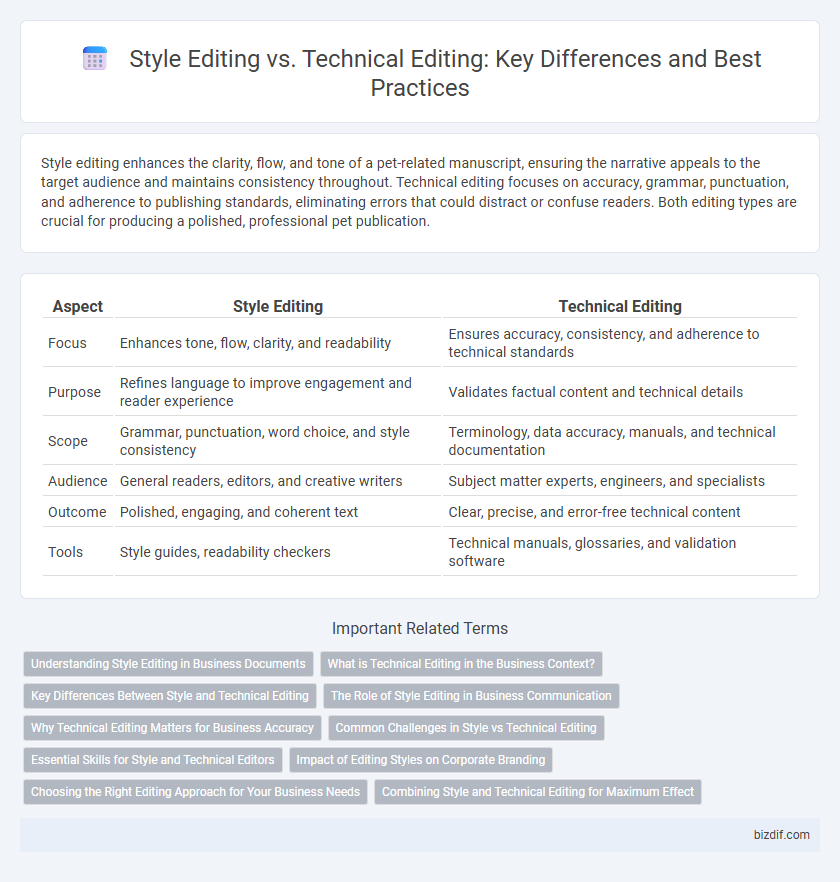Style editing enhances the clarity, flow, and tone of a pet-related manuscript, ensuring the narrative appeals to the target audience and maintains consistency throughout. Technical editing focuses on accuracy, grammar, punctuation, and adherence to publishing standards, eliminating errors that could distract or confuse readers. Both editing types are crucial for producing a polished, professional pet publication.
Table of Comparison
| Aspect | Style Editing | Technical Editing |
|---|---|---|
| Focus | Enhances tone, flow, clarity, and readability | Ensures accuracy, consistency, and adherence to technical standards |
| Purpose | Refines language to improve engagement and reader experience | Validates factual content and technical details |
| Scope | Grammar, punctuation, word choice, and style consistency | Terminology, data accuracy, manuals, and technical documentation |
| Audience | General readers, editors, and creative writers | Subject matter experts, engineers, and specialists |
| Outcome | Polished, engaging, and coherent text | Clear, precise, and error-free technical content |
| Tools | Style guides, readability checkers | Technical manuals, glossaries, and validation software |
Understanding Style Editing in Business Documents
Style editing in business documents enhances clarity by refining tone, word choice, and sentence structure to align with the target audience and brand voice. It ensures consistency in terminology, improves readability, and maintains professionalism without altering the core content. This process differs from technical editing, which primarily focuses on factual accuracy, formatting, and compliance with industry standards.
What is Technical Editing in the Business Context?
Technical editing in the business context involves reviewing documents to ensure clarity, accuracy, and consistency of specialized content, including user manuals, reports, and proposals. It requires a deep understanding of industry-specific terminology, standards, and regulatory compliance to make information accessible and error-free. Unlike style editing, technical editing prioritizes the correctness and functionality of technical information over general language flow or aesthetic concerns.
Key Differences Between Style and Technical Editing
Style editing focuses on enhancing the readability, tone, and flow of a document by refining language, sentence structure, and overall coherence. Technical editing emphasizes accuracy, clarity, and consistency of specialized content, ensuring terminology, data, and formatting adhere to industry standards. The key differences lie in style editing's attention to narrative polish versus technical editing's focus on factual precision and adherence to technical guidelines.
The Role of Style Editing in Business Communication
Style editing enhances clarity, tone, and consistency, ensuring business messages resonate effectively with target audiences. By refining word choice, sentence structure, and overall flow, style editing improves readability and strengthens the brand's voice in professional documents. This editing approach differs from technical editing, which focuses on accuracy, jargon, and adherence to industry standards.
Why Technical Editing Matters for Business Accuracy
Technical editing ensures business documents uphold accuracy by thoroughly verifying data, terminology, and compliance with industry standards, which minimizes costly errors and misinterpretations. Unlike style editing, which concentrates on readability and tone, technical editing enhances clarity and precision essential for legal contracts, manuals, and reports. Prioritizing technical editing improves decision-making and maintains professional credibility in competitive markets.
Common Challenges in Style vs Technical Editing
Common challenges in style editing include maintaining consistent tone, voice, and clarity while adapting content to the target audience and purpose. Technical editing, on the other hand, requires precise accuracy in terminology, data verification, and adherence to specific formatting or industry standards. Both types demand meticulous attention to detail but differ significantly in focus: style editing emphasizes readability and engagement, whereas technical editing prioritizes factual correctness and structural compliance.
Essential Skills for Style and Technical Editors
Style editors excel in refining tone, clarity, and consistency to enhance readability and ensure the manuscript aligns with the intended audience and genre. Technical editors possess expertise in subject-specific terminology, factual accuracy, and adherence to industry standards, crucial for maintaining the integrity of specialized content. Both roles require strong attention to detail, proficiency in relevant language rules, and the ability to collaborate effectively with authors and other editors.
Impact of Editing Styles on Corporate Branding
Style editing enhances corporate branding by refining tone, voice, and consistency, ensuring the brand message resonates clearly with the target audience. Technical editing guarantees accuracy, clarity, and compliance, maintaining the brand's credibility and professional reputation in specialized communications. Both editing styles synergize to elevate overall brand perception, reinforcing trust and authority in the marketplace.
Choosing the Right Editing Approach for Your Business Needs
Choosing the right editing approach depends on your business goals and target audience. Style editing hones clarity, tone, and flow to enhance reader engagement, while technical editing ensures accuracy, consistency, and adherence to industry standards. Prioritize style editing for brand voice refinement and technical editing for precise, error-free content in specialized fields.
Combining Style and Technical Editing for Maximum Effect
Combining style editing and technical editing enhances the clarity, coherence, and professionalism of a document by ensuring both language flow and factual accuracy are refined simultaneously. Style editing improves tone, voice, and readability, while technical editing addresses grammar, punctuation, and domain-specific terminology. Integrating these approaches maximizes the overall impact by producing polished, error-free content that effectively communicates the intended message.
Style Editing vs Technical Editing Infographic

 bizdif.com
bizdif.com